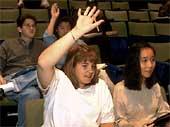In recent years, women have become more prominent in chemistry and biology; however, they remain underrepresented in physics. Furthermore, on average, women do not perform as well as men in college or university introductory physics. Studies of elementary and secondary education suggest that these disparities originate when students are in junior high or high school. What can be done in college and university classes to reverse this trend? Some studies have shown that women do better in science classes that are taught cooperatively, rather than competitively, and benefit from classes that challenge every student to think about and respond to questions asked during class. Peer Instruction clearly fits this description. However, a strong emphasis on developing and practicing quantitative and spatial skills is also thought to promote female success. This raises the following question: Does Peer Instruction, which puts less emphasis on quantitative skills than traditional approaches, nevertheless yield a more gender-balanced pattern of success?
Mazur Group
Plainly Speaking
Can pedagogy alleviate the well-known "gender gap" in performance and representation in the physical sciences? Peer Instruction provides a cooperative learning environment and challenges every student to think during class. These two qualities are thought to promote success of female students.

We are studying whether female students indeed succeed on a par with male students in introductory physics taught with Peer Instruction.
Copyright © 2024 The President and Fellows of Harvard College | Accessibility | Digital Accessibility | Report Copyright Infringement